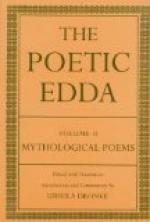Dr. Storm has an interesting article on the Norse belief in Re-birth in the Arkiv for Nordisk Filologi, ix. He collects instances, and among other arguments points out the Norse custom of naming a posthumous child after its dead father as a probable relic of the belief. The inheritance of luck may perhaps be another survival; a notable instance occurs in Viga-Glums Saga, where the warrior Vigfus bequeaths his luck to his favourite grandson, Glum. In the Waterdale Saga there are two instances in which it is stated that the luck of the dead grandfather will pass to the grandson who receives his name. Scholars do not, however, agree as to the place of the rebirth idea in the Helgi poems, some holding the view that it is an essential part of the story.
Hunding. (Page 32.)
It is possible that the werwolf story is a totem survival. If so, the Hunding feud might easily belong to it: dogs are the natural enemies of wolves. It is curious that the Irish werwolf Cormac has a feud with MacCon (i.e., Son of a Dog), which means the same as Hunding. This story, which has not been printed, will be found in the Bodleian MS. Laud, 610.
Thorgerd Holgabrud. (Page 33.)
Told in Saxo, Book ii. Snorri has a bare allusion to it.
Holger Danske, or Ogier Le Danois. (Page 33.)
See Corpus Poeticum Boreale, vol. i. p. cxxx., and No. 10 of this series. The Norse version of the story (Helgi Thorisson) is told in the Saga of Olaf Tryggvason, and is summarised by Dr. Rydberg in the Teutonic Mythology, and by Mr. Nutt in the Voyage of Bran.
Ballads. (Page 36.)
Professor Child is perhaps hasty in regarding the two parts of Clerk Saunders as independent. The first part, though unlike the Helgi story in circumstance, seems to preserve the tradition of the hero’s hostility to his bride’s kindred, and his death at their hands.
The Helgi story, in all its variants, is as familiar in Danish as in Border ballads. The distribution of the material in Iceland, Denmark, England and Scotland is strongly in favour of the presumption that Scandinavian legend influenced England and Scotland, and against the presumption that the poems in question passed from the British Isles to Iceland. The evidence of the Danish ballads should be conclusive on this point. There is an English translation of the latter by R.C.A. Prior (Ancient Danish Ballads, London, 1860).
The Everlasting Battle. (Page 39.)
The Skald Bragi (before 850 A.D.) has a poem on this subject, given with a translation in the Corpus, vol. ii. Saxo’s version is in the fifth book of his History. According to Bragi, Hild has a necklace, which has caused comparison of this story with that of the Greek Eriphyle. Irish legendary history describes a similar battle in which the slain revive each night and renew the fight daily, as occurring in the wanderings of the Tuatha De Danann before they reached Ireland. According to Keating, they learnt the art of necromancy in the East, and taught it to the Danes.




